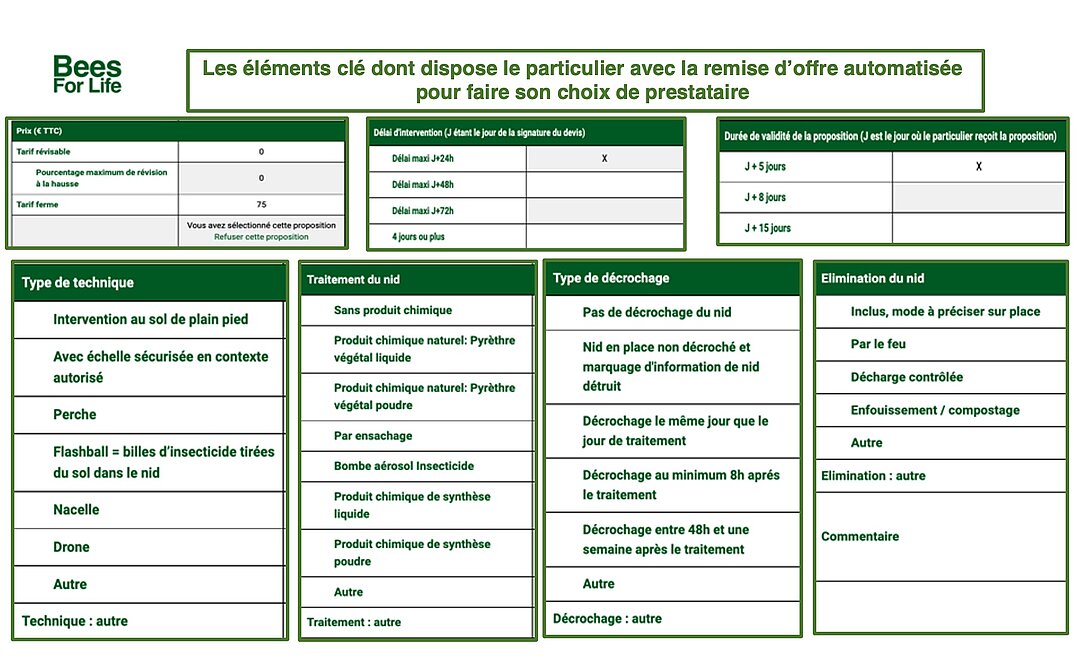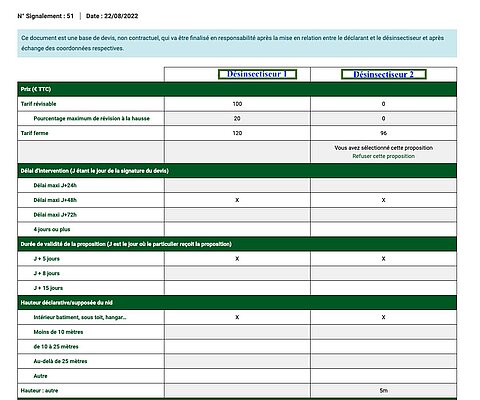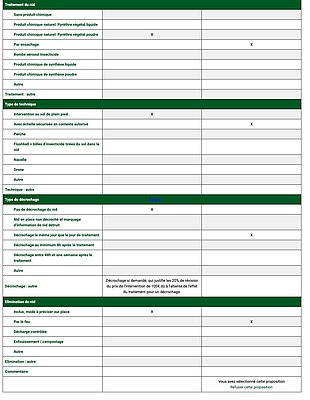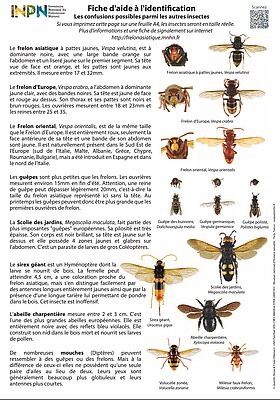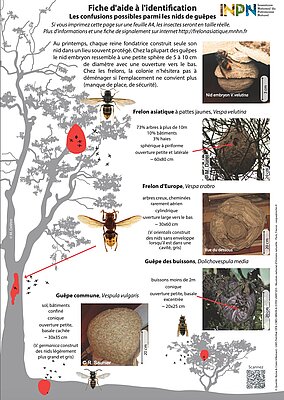Quotations: what information should be provided to enable private individuals or local authority representatives to choose the service provider according to their priorities?
The standard estimate: the result of collaborative work with private individuals, local authorities and professionals in the sector.
To make it easier for private individuals to read the service offers they may receive from insect killers, this standard estimate has been drawn up and automatically managed in the BeesForLife reporting application.
If they wish, insect killers can provide further details in the various comment areas available.
Nest reporters can thus choose the offer that seems best suited to their safety, environmental, price and response time concerns, etc.
A simple click by the declarant puts the declarant in contact with the chosen disinsector, enabling the destruction to be carried out in complete transparency.
Questions - Answers on the BeesForLife quotation issued by the pest control company to the person reporting a nest
Below are some answers to the questions you may have. The aim of this information is to make you aware of the best practices you should adopt to protect bees and ensure the safety of people who may be exposed to the Asian hornet.
Using the standard estimate, professionals will make proposals that they feel are appropriate to the situation, based on your communication.
The financial aspect is one of these considerations. The Asian hornet is recognised in Europe as a harmful insect, but the French government does not currently provide direct support to private individuals who take action in the public interest by reporting and destroying nests.
However, some local authorities help to support BeesForLife-type actions and/or work alongside private individuals in various ways to make it easier for them to protect bees, pollinators and people.
There are 3 major issues involved in destroying the pest: preserving pollinators and the environment , protecting bees and ensuring public safety.
At the very least, the control method is based on destroying V. velutina nests around apiaries, at distances that make them likely to exert predation pressure. By reducing the number of nests, the aim is to reduce the pressure exerted by the hornets on the worker bees in the apiary. As a result, the claustration of colonies can be reduced, allowing foraging activity to continue.
In an urban environment, the Asian hornet is a risk when it is "disturbed" in its activity. For example
- in public parks (play areas, proximity of flowers and plants attractive to insects)
- or private gardens (e.g. hedge trimming, maintenance of green areas)
human activity can be exposed to this risk.
It is therefore advisable to call in a professional to destroy any nests you may have identified.
Personal safety
Destroying a V. velutina nest is a dangerous operation, involving large numbers of hornets who behave very aggressively. It is therefore important that only qualified and duly equipped people carry out the destruction.
2.1. PUBLIC SAFETY
The risk associated with the behaviour of the colony means that people (and pets) not involved in destroying the nest should be at least 50 m away from the nest, or sheltered in a room. In the event of heavy traffic or crowds of people, a safety perimeter must be set up.
2.2. OPERATOR SAFETY
Destroying nests is a dangerous operation, particularly for the operator carrying out the destruction. The Personal Protective Equipment (PPE) required can be adapted according to the type of risk involved.
Protection against V. velutina
Any operator destroying a nest must at least be equipped with an anti-hornet suit. As the speed of flight of V. velutina and the power of the impact when stung are greater than those of the European hornet Vespa crabro, it is advisable to wear thick clothing under the suit.
You should also wear :
- eye protection against the irritating splashes produced by V. velutina workers,
- thick, hard-wearing gloves if the overalls are not so equipped,
- thick, high-cut shoes.
Handling biocides
The preparation and use of biocides for destruction may mean that the operator's equipment needs to be modified or supplemented, depending on the labelling instructions. In particular, a specific type of glove (material, mark of conformity) or inhalation mask (standard, mark of conformity) may be required.
Working at height
The location of certain nests may require the operator to work at height. In this case, the regulations in force should be consulted. Certain basic rules relating to working at height must also be observed:
- The destruction must involve two operators.
- The operator destroying the nest at height must be secured by a rope and suitable equipment.
- In the event of an accident, the other operator must be able to come to the nest's aid from the ground, i.e. lower it down and provide emergency first aid.
TAKE THE SEASON INTO ACCOUNT
The location of a nest can vary as it develops. The (embryonic) nest built by the overwintering foundress is generally located at low level and in protected areas. During this period, there is competition between foundresses, which can lead to the conquest of an embryonic nest by another foundress. When the first workers emerge, the (primary) colony continues to develop on this site. If its location does not allow it to expand, the workers relocate the colony by building a secondary nest, at greater heights and in more exposed locations, generally in the canopy of a tree. The queen will migrate there to continue laying her eggs. In autumn, the emergence of the first males, followed by the future foundresses, heralds the end of nest development.
Destroying nests early has the dual advantage of targeting nests that are both small and more accessible, and of destroying colonies before they have caused any damage to apiaries. Nest destruction should continue throughout the summer and autumn, until November. After that, as most of the future foundresses have left the nest and the individuals remaining in the nest are destined to die there, there is little point in destroying them.
TAKE INTO ACCOUNT THE TIME OF DAY
V. velutina is active only during the day. At night, individuals gather in their nests. Destroying nests at dusk or at night will eliminate almost all the individuals and minimise the risk of the colony relocating.
On the other hand, destroying nests during the day, when some workers are absent from the nest, causes certain inconveniences. On returning to the site of destruction, the workers in search of their nest display aggressive behaviour for several days, posing a risk to the surrounding population. What's more, the risk of "new" nests being built, either by the queen or by these workers, is increased if the queen is one of the hornets present. In a nest containing the queen, the colony could still produce sexual males and females. In the opposite case, although nests founded by workers (unfertilised females) only produce males, predation activity and the associated nuisance would also continue. Generally speaking, a nest without a queen will gradually reduce its activity.
Nest identification
Before destroying any nest, it is advisable to check that it is indeed a V. velutina nest, using theMnHn identification sheets: source https://frelonasiatique.mnhn.fr/wp-content/uploads/sites/10/2021/10/Fiches_Identification_Vespa_velutina_MNHN.pdf
Further information is also available on the BeesForLife website
We recommend that you report the nest to the Organisme à Vocation Sanitaire, which will then appoint a contact person to confirm identification (on the basis of a photo or an individual caught nearby), or to your local council.
The town hall may be equipped with the BeesForLife platform, which is used to submit your report under the town's responsibility. You can also access the BeesForLife platform outside the context of your town and find useful information for your nest identification. You can also submit your report on the BeesForLife platform using the form. Without taking any responsibility for the result, BeesForlife will forward this information by e-mail to your local authority to find out their policy on this pest, the Asian Hornet Vespa velutina Nigrithorax.
Access to the nest
Whatever the type of destruction envisaged, the nest should be approached as discreetly as possible, so as not to alert the colony, which would stimulate defensive behaviour (e.g. the emergence of aggressive worker bees). In particular, access to the active nest must not cause any vibration of the support to which it is attached (typically a tree).
The destruction of nests located high up can be facilitated by various means (which may be combined):
- using a ladder, which must be combined with PPE (Personal Protective Equipment) to protect the operator from falling,
- The use of a telescopic pole to inject a biocide (injector at the top of the pole, injection activation device at the bottom) and then remove the nest (blade at the top of the pole) from a distance.
- the use of a gondola (the mobilisation of which increases the cost of the operation),
Where access to the nest allows, it is always preferable to obstruct the entrance(s) to the nest (e.g. with polystyrene foam) before destroying it.
MECHANICAL DESTRUCTION
This method of destruction is preferable for nests that are easily accessible and/or small in size. It involves quickly blocking the entrance(s) to the nest, then wrapping it in a receptacle (bag, container) strong enough to prevent the hornets from perforating the walls before destroying the nest. The nest must then be quickly removed, the receptacle hermetically sealed and destroyed by prolonged freezing (minimum 48 hours).
Destruction using firearms, water hoses, arrows or any other method likely to cause individuals to disperse and the nest to relocate is absolutely prohibited.
Choice of biocide
The insecticides that can be used to destroy V. velutina nests are biocidal products in group 3: Pest control products - Product Type 18 - products that kill wasps and hornets. Depending on the conditions of use, the choice of commercial speciality to be injected must take into account the form (powder, liquid) and characteristics (shock action, persistence, toxicity) of the biocide.
In all cases, the conditions of use indicated on the labelling must be respected. Remember that sulphur dioxide (SO2) does not belong to the category of biocides authorised for this use. It also presents a high risk for the operator.
Injecting the biocide
The upper part of the nest, made up of an aggregate of fragments of bark mixed with saliva, protects the nest from bad weather. It is in the nest, which houses the brood cakes and is where the colony lives, that the biocide must be injected.
To do this, the injector is inserted through the envelope, under the agglomerate (approximately under the upper third of the nest). The form of the product (powder, liquid) and the method of injection should be chosen to promote dispersion of the biocide throughout the nest.
Injecting an excessive quantity of liquid biocide into a nest made up of agglomerated fragments of bark could, in certain cases, lead to a risk of dislocation before the nest is removed. The form (powder, liquid) and quantity of biocide injected should therefore be defined with this risk in mind.
Removing the nest
Whatever biocide is used, it is important to remove the nest within 72 hours of injection so as not to expose the environment (and in particular the birds which, once the nest has been cleared of its guardians, could come and feed on the dead larvae coated with the biocide).
If access to the nest allows, it will be wrapped in a container (in the same way as for mechanical destruction), unhooked and then removed for destruction. For nests that are difficult to access (e.g. high up or tangled in branches), the nest can be removed using a saw attached to the end of a telescopic pole. If the nest falls and breaks up, there is a risk that the biocide will be dispersed in the environment. One best practice is to lay tarpaulins on the ground to collect the nest fragments and the biocide they contain.

